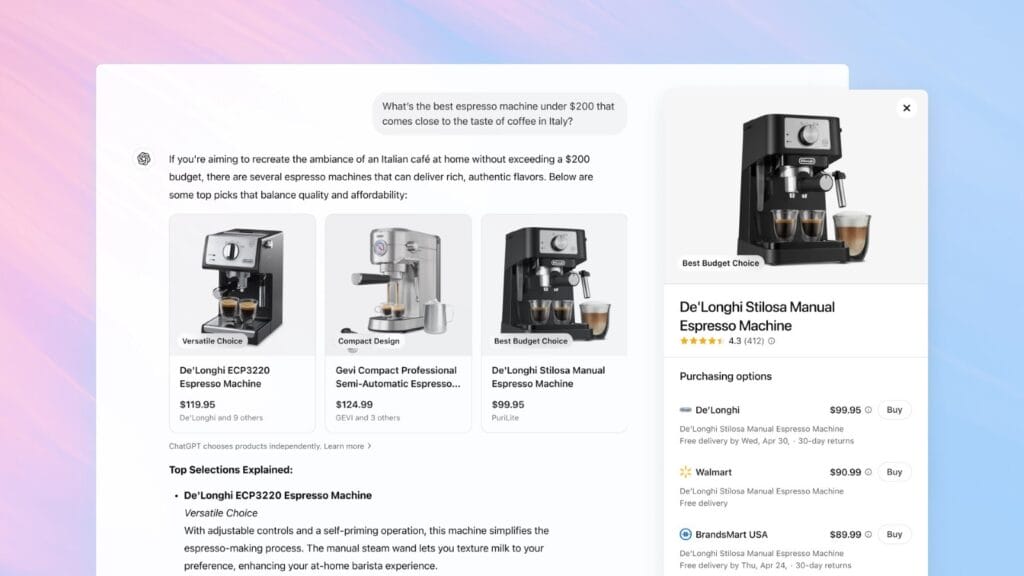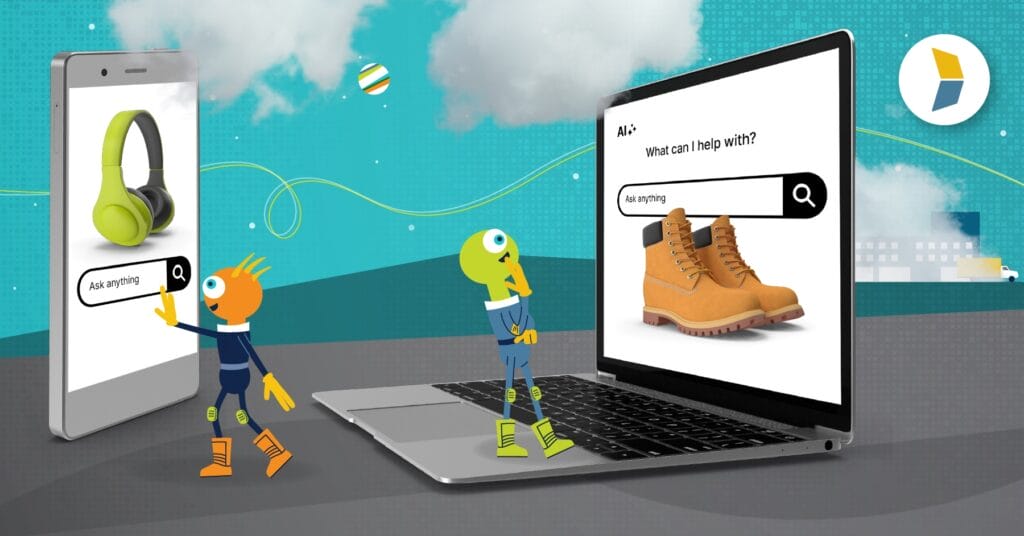At one time, shopping meant driving to a store, browsing aisles, and lining up at the register. That time has long passed. Today, consumers shop everywhere: on their phones, laptops, through social media feeds, and yes, still in-store.
But there’s a new channel entering the mix: AI tools like ChatGPT.
Unlike traditional shopping experiences, AI does all of the heavy lifting. Want a quick comparison of the best wireless earbuds under $200? ChatGPT can help. Curious which iPhone model offers the best value right now? AI can walk you through prices and a feature breakdown in seconds.
AI is becoming a shopping assistant, product expert, and trusted guide rolled into one, and consumers are beginning to rely on it more and more.
In this post, we’ll explore how consumers use AI to shop, what brands can do to stand out in AI-powered conversations, the pros and cons of this, and the latest shopping features built into ChatGPT. Let’s get to it!
A New Era: The AI shopping assistant
In the few years AI has been around, it has quickly gone from novelty to necessity.
Since ChatGPT’s public launch in late 2022, millions of consumers have started turning to conversational AI for tasks they once reserved for Google. Competitors like Google Gemini, Perplexity, and Claude have followed, but ChatGPT remains a standout for its ease of use and growing ecosystem of plugins and integrations.
And as generative AI becomes more accessible, shoppers use it to fuel their purchasing journey. Nearly 3 in 5 consumers have replaced traditional search engines with AI. They’re leveraging it as a luxury experience: enabling smarter, faster, more personalized purchasing decisions. Here’s how:
- Discovering brands and products: Instead of searching “natural skincare brands” and sifting through Google or scrolling through UGC content on social media, users ask ChatGPT for clean, cruelty-free skincare recommendations and get curated suggestions instantly.
- Comparing features, prices, and reviews: AI can surface side-by-side comparisons across dozens of products, pulling insights from reviews, specs, and third-party sources in seconds.
- Requesting tailored recommendations: Whether it’s “best hiking boots for wide feet” or “affordable air purifiers for allergies,” shoppers get context-aware suggestions that mimic talking to a well-informed friend.
Many users find AI more intuitive than Google search because of its personalization features (analyzing past history and preferences) along with its ability to handle precise inquiries. Instead of clicking through five tabs and reading hundreds of reviews, the entire decision-making process happens in one place: the chat.
AI shopping is more than a shift in how people research and purchase products. It’s a fundamental rethinking of where and why discovery happens.
How ecommerce brands can optimize for AI shopping
Optimize content for conversational queries
AI shopping thrives on conversations, so your content should too. Use plain, conversational language in product descriptions, FAQs, and meta tags. Consumers aren’t searching for “hydration facial cream hyaluronic acid 1.7oz” they’re asking, “What’s a good lightweight moisturizer for dry skin in winter?”
Focus on use cases and benefits, not just specs. Think less “Stainless Steel 12oz Insulated Tumbler,” and more “Keeps coffee hot for 6 hours.”
Help the algorithm understand your product
If you want ChatGPT to recommend your products, it needs to understand them. This means providing clean, structured, and current information.
- Use structured data like schema markup to label product attributes (price, size, color, reviews, etc.). This helps AI tools find and display your content accurately.
- Keep your reviews and Q&A content fresh. Language learning models often summarize review sentiment, so the more detailed feedback you have, the better.
Ensure your site is crawlable by ChatGPT’s search bot
Like traditional search engines, ChatGPT uses an OAI-SearchBot crawler to discover and surface web content. To be included in AI-powered shopping results, make sure your site isn’t blocking this bot in your robots.txt file.
Track ChatGPT-driven traffic
When users click on links from ChatGPT search results, the referral URL includes a utm_source=chatgpt.com tag, making it easy to monitor and analyze traffic in tools like Google Analytics. Keep an eye out for this type of traffic and optimize pages accordingly.
Partner with AI-friendly platforms
AI tools rely on integrations and partnerships to serve up shopping content. If your products aren’t listed on those platforms, you might not show up, even if your brand is a perfect match for the inquiry.
- Submit product feeds to platforms that partner with AI models like Klarna Shopping for product discovery within ChatGPT.
- Ensure your Amazon, Walmart Marketplace, or Target+ listings are accurate, as these are common sources for third-party data scraped by AI.
Remember to use consistent naming conventions and product images across platforms. AI models prefer clear, repeatable identifiers to match and verify listings.
Sign up to be notified when ChatGPT product feed submissions open
While ChatGPT doesn’t currently accept product feeds from merchants, they plan to enable it in the future to ensure accurate, up-to-date listings. Retailers can complete an interest form to be notified once submissions open.
New 2025 ChatGPT shopping features

Source: OpenAI
OpenAI announced last month the rollout of a new shopping experience across GPT-4o and GPT-4o-mini for all users. When users ask product-related questions, ChatGPT now displays visually rich product carousels with:
- Product images and simplified descriptions
- Price and ratings from third-party sources
- Links to merchants where items can be purchased
It’s important to note that these product suggestions are not ads. ChatGPT chooses them independently based on user intent and context (including chat history or custom instructions).
How are products selected?
ChatGPT determines what to show based on user input, past preferences, and third-party provider data. For example, if a user has already let ChatGPT know they dislike clowns, ChatGPT may skip clown costumes within a costume search. Users can always clarify preferences to refine results.
Additional features:
- Custom labels like “Budget-friendly” or “Most popular” are generated by the model
- Summarized reviews and star ratings based on third-party content
- Price information that may include multiple merchants per product
Shopping with ChatGPT doesn’t come without its caveats. With any AI model, the information it pulls may lag behind real-time updates. This means that users may not always get the most up-to-date information around prices, availability, and product details.
Pros and Cons of AI-Powered Shopping
Pros:
- Being AI-friendly enables a discovery channel beyond traditional search. When done well, it’s an opportunity for brands to get in front of engaged shoppers.
- Customers discovering products through AI conversations are often further along in the buying journey. Typically, they are ready to make a decision and are using AI to refine their choices.
- Because AI leverages a brand’s existing content, like reviews, FAQs, and product data, it makes this type of content more valuable.
Cons:
- Optimizing for AI is no small feat. It requires continuous updates on product data and implementing schema markup.
- Visibility isn’t guaranteed without proper optimization or presence on AI-partnered platforms.
- Because ChatGPT will curate and generate product summaries from third-party data (and create labels like ‘budget-friendly’), brands have less control over presentation and the user experience.
The future of AI shopping in ecommerce
We’re entering an era where chat-based commerce is becoming a core layer of the ecommerce experience. From AI shopping assistants embedded into brand websites to voice-powered product discovery via smart devices, the way consumers browse, compare, and buy is shifting fast.
Retailers that want to boost customer loyalty must optimize for discovery inside AI tools, build intuitive experiences with product data, and stay nimble as shopping becomes more interactive and conversational.
For brands, the key to success isn’t fighting the shift – it’s figuring out how to show up inside the conversation.


